| Revision as of 11:58, 18 January 2011 editTajik (talk | contribs)11,859 editsm →Demographics← Previous edit | Revision as of 10:18, 19 January 2011 edit undoCla68 (talk | contribs)Autopatrolled, Pending changes reviewers48,127 edits →Pollution: detail and citeNext edit → | ||
| Line 312: | Line 312: | ||
| ] | ] | ||
| The air pollution is due to several different reasons.{{Citation needed|date=January 2010}} 1) Economical: most Iranian industries are located on the outskirts of Tehran. The city is also overrun with old and aging cars which do not meet today's emission regulations. Furthermore, Iran's busiest airport, ], is located in the west of the city; 2) Most people are then obliged to either use private cars or hire taxis. This has created severe ]; 3) Geographical: Tehran is bound in the north by the massive ] mountain range that is stopping the flow of the humid Caspian wind. As a result, ] that traps Tehran's polluted air is frequently observed. The lack of humidity and clouds makes Tehran a very sunny city. The UV radiations then combined with the existing pollutants significantly raise the level of the ]. | The air pollution is due to several different reasons.{{Citation needed|date=January 2010}} 1) Economical: most Iranian industries are located on the outskirts of Tehran. The city is also overrun with old and aging cars which do not meet today's emission regulations. Furthermore, Iran's busiest airport, ], is located in the west of the city; 2) Most people are then obliged to either use private cars or hire taxis. This has created severe ]; 3) Geographical: Tehran is bound in the north by the massive ] mountain range that is stopping the flow of the humid Caspian wind. As a result, ] that traps Tehran's polluted air is frequently observed. The lack of humidity and clouds makes Tehran a very sunny city. The UV radiations then combined with the existing pollutants significantly raise the level of the ]. Furthermore, the reportedly poor quality of Iranian-manufactured gasoline may also be contributing to the pollution.<ref>'']'', "The smoggiest of all capitals", 1 January 2011, p. 40.</ref> | ||
| The government, however, is engaged in a battle to reduce the air pollution.{{Citation needed|date=January 2010}} It has for instance encouraged taxis and buses to convert from petrol engines to engines that run on ]. Furthermore, since 1979 the government of the Islamic Republic of Iran has set up a "Traffic Zone" (طرح ترافیک) covering the city center during peak traffic hours. Entering and driving inside this zone is only allowed with a special permit. The government is also trying to raise people's awareness about the hazards of the pollution. One method that is currently been employed is the installation of Pollution Indicator Boards all around the city to monitor the current level of ] (PM10), ] (NO<sub>2</sub>), ozone (O<sub>3</sub>), ] (SO<sub>2</sub>), and ] (CO). The board also displays the ] (PSI), which is a general indication of air quality based on the measurements of the above-mentioned five pollutants. The Pollution Indicator Boards classify the level of each pollutants as either safe, hazardous or dangerous. | The government, however, is engaged in a battle to reduce the air pollution.{{Citation needed|date=January 2010}} It has for instance encouraged taxis and buses to convert from petrol engines to engines that run on ]. Furthermore, since 1979 the government of the Islamic Republic of Iran has set up a "Traffic Zone" (طرح ترافیک) covering the city center during peak traffic hours. Entering and driving inside this zone is only allowed with a special permit. The government is also trying to raise people's awareness about the hazards of the pollution. One method that is currently been employed is the installation of Pollution Indicator Boards all around the city to monitor the current level of ] (PM10), ] (NO<sub>2</sub>), ozone (O<sub>3</sub>), ] (SO<sub>2</sub>), and ] (CO). The board also displays the ] (PSI), which is a general indication of air quality based on the measurements of the above-mentioned five pollutants. The Pollution Indicator Boards classify the level of each pollutants as either safe, hazardous or dangerous. | ||
Revision as of 10:18, 19 January 2011
This article is about the Iranian capital city. For other uses, see Tehran (disambiguation).35°41′46″N 51°25′23″E / 35.69611°N 51.42306°E / 35.69611; 51.42306
Metropolis in Iran| Tehran تهران Tehrān | |
|---|---|
| Metropolis | |
| Tehran SkylineTehran Skyline | |
| Official seal of TehranSeal | |
| Country | |
| Province | Tehran |
| County | Tehran County Rey County Shemiranat County |
| Government | |
| • Mayor | Mohammad Bagher Ghalibaf |
| • City Council | Chairman: Mehdi Chamran |
| Area | |
| • Urban | 400 km (200 sq mi) |
| • Metro | 730 km (280 sq mi) |
| Elevation | 1,200 m (3,900 ft) |
| Population | |
| • Density | 10,327.6/km (26,748.3/sq mi) |
| • Urban | 8,429,807 |
| • Metro | 13,413,348 |
| • Population Rank in Iran | 1st |
| Population Data from 2006 Census and Tehran Municipality. Metro area figure refers to Tehran Province. | |
| Time zone | UTC+3:30 (IRST) |
| • Summer (DST) | UTC+4:30 (IRDT) |
| Area code | 021 |
| Website | www.tehran.ir |
Tehran (Persian: تهران Tehrān Template:IPA-fa), in languages with Latin characters often Teheran, is the capital of Iran and Tehran Province. With a population of 8,429,807; it is also Iran's largest urban area and city, one of the largest cities in Western Asia, and is the 21st largest city in the world.
Tehran is the centre of most Iranian industries including automotive, electrical, military, weaponry, textiles, sugar, cement, and chemical. Tehran is also a leading centre for the sale of carpets and furniture. There is an oil refinery located south of the city.
In the 20th century, Tehran was subject to mass-migration of people from all around Iran. The main and original inhabitants of the city are Persians and the principal language of the city is Persian with Tehranese accent spoken natively by over 98% of the city's population .The rest 2% are immigrant minority languages including Gilaki, Mazandarani, Armenian, Arabic, Azerbaijani Turkic, Kurdish and Luri and the lingua franca between these ethnic groups is Persian . The city is home to many historic mosques, churches, synagogues and Zoroastrian fire temples. Contemporary Tehran is a modern city featuring many tall structures, of which the Azadi (Freedom) Tower and the Milad Tower have come to be symbols of Tehran itself. Internationally Tehran was in 2008, the least expensive capital in the world and only the second least expensive city globally based on Cost-of-living index, in addition to presenting the best value for money in the world. Furthermore globally it stands 19th by city population, 56th by the size of its GDP and 29th by the population of its metropolitan area. Due to long history of Iran, there have been many instances of capital city relocations over the ages and Tehran, currently is the 32nd national capital of Iran.
History




The origin of the name Tehran is unknown. Tehran was well known as a village in the 9th century, but was less well-known than the city of Rhages (Ray) which was flourishing nearby in the early era. In the 13th century, following the destruction of Ray by Mongols, many of its inhabitants escaped to Tehran. In some sources of the early era, the city is mentioned as "Rhages's Tehran" . The city is later mentioned in Hamdollah Mostowfi's Nuz'hat al-Qulub (written in 1340) as a famous village.
Don Ruy Gonzáles de Clavijo, a Castilian ambassador, was probably the first European to visit Tehran, stopping in July 1404, while on a journey to Samarkand (now in Uzbekistan) and the Mongol capital at the time. At this time, the city of Tehran was unwalled.
Tehran became a residence of the Safavid rulers in the 17th century. Tahmasp I built a bazaar and a wall around the city, but it somewhat fell out of favor after Abbas I turned sick when he was passing the city to go to a war with the Uzbeks.
In the early of 18th century, Karim Khan Zand ordered a palace, and a government office to be built in Tehran, possibly to declare the city his capital, but later moved his government to Shiraz. Tehran finally became the capital of Iran in 1795, when the Qajar king Agha Mohammad Khan was crowned in the city. It remains the capital to this day.
In the 1920s and 30's, the city essentially was started from scratch under the rule of the Shah of Iran, Reza Shah Pahlavi. Reza Shah believed that ancient buildings such as large parts of the Golestan Palace, Takieh-ye Dowlat, the Toopkhaneh Square, the city fortifications and the old citadel among others should not be part of a modern city. They were systematically destroyed and modern buildings with pre-islamic Iranian style, such as the National Bank, Police Headquarter, Telegraph Office and Military Academy were built in their place. The Tehran Bazaar was divided in half and many historic buildings were destroyed in order to build wide straight avenues in the capital. Many examples of Persian Gardens also became targets to new construction projects.
During World War II, British and Soviet troops entered the city. Tehran was the site of the Tehran Conference in 1943, attended by U.S. President Franklin D. Roosevelt, British Prime Minister Winston Churchill, and Soviet Premier Joseph Stalin.
In the 1960s and 70's Tehran was rapidly developing under the reign of Shah Mohammed Reza Pahlavi. Modern Buildings altered the face of Tehran and ambitious projects were envisioned for the following decades. The majority of these projects were stopped by the Islamic Revolution 1979, with few elements of them, such as the Milad Tower, being built under the new regime decades later.
During the 1980–88 Iran–Iraq War, Tehran was the scene of repeated Scud missile attacks and air strikes against random residential and industrial targets within the city, resulting in thousands of civilian casualties. Material damage was repaired soon after each strike. Tehran attracted war refugees by the millions.
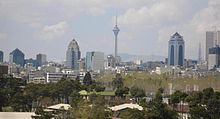
After the war, cheap Soviet-style apartments multiplied throughout the city without any plan. At present, little is left of Tehran's old quarters. Instead, modern high-rise buildings dominate the city's skyline and new modern apartments have and are replacing the few remaining old houses at a rapid pace. Tehran-style home architecture has almost vanished completely. This is often referred to as "Tehran Identity Disaster".
Tehran is also home to many grand mansions in the north of the city such as those in Farmanieh, Zaferanieh, Niavaran.
-
 Tehran Bazaar
Tehran Bazaar
-
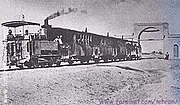 Tehran Trainold in 1880's
Tehran Trainold in 1880's
-
 Tehran Conference
Tehran Conference
-
 Toopkhaneh square (now Imam square)
Toopkhaneh square (now Imam square)
-
 An Opposition parade in Tehran, 1979
An Opposition parade in Tehran, 1979
Climate
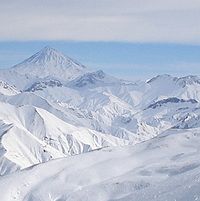
Tehran features a semi-arid, continental climate (Köppen climate classification BSk). Tehran's climate is largely defined by its geographic location, with the towering Alborz Mountains to its north and the central desert to the south. It can be generally described as mild in the spring, hot and dry in the summer, pleasant in the autumn, and cold in the winter. As a large city with a significant differences in elevation among various districts, the weather is often cooler in the hilly north as compared to the flat southern part of Tehran.
Summer is usually hot and dry with very little rain, but relative humidity is generally low and the nights are cool. The majority of the light annual precipitation occurs from late-autumn to mid-spring, but no one month is particularly wet. The hottest month is July (mean minimum temperature 26°C, mean maximum temperature 36°C) and the coldest is January (mean minimum temperature -1°C, mean maximum temperature 8°C)
Although compared with other parts of the country Tehran enjoys a more moderate climate, weather conditions can sometimes be unpredictably harsh. The record high temperature is 43°C and the record low is -15°C. On January 5 & 6, 2008, after years of relatively little snow, a wave of heavy snow and low temperatures shocked the city covering it in a thick layer of snow and ice, forcing the Council of Ministers to officially declare an state of emergency and calling the following two days (January 6 and 7) off for the capital.
| Climate data for Tehran | |||||||||||||
|---|---|---|---|---|---|---|---|---|---|---|---|---|---|
| Month | Jan | Feb | Mar | Apr | May | Jun | Jul | Aug | Sep | Oct | Nov | Dec | Year |
| Record high °C (°F) | 19.6 (67.3) |
23 (73) |
28 (82) |
32.4 (90.3) |
37 (99) |
41 (106) |
43 (109) |
42 (108) |
38 (100) |
33.4 (92.1) |
26 (79) |
21 (70) |
43 (109) |
| Mean daily maximum °C (°F) | 7.9 (46.2) |
10.4 (50.7) |
15.4 (59.7) |
22.1 (71.8) |
27.9 (82.2) |
33.9 (93.0) |
36.6 (97.9) |
35.6 (96.1) |
31.6 (88.9) |
24.4 (75.9) |
16.2 (61.2) |
10 (50) |
22.7 (72.9) |
| Mean daily minimum °C (°F) | −1 (30) |
1 (34) |
5 (41) |
12 (54) |
16 (61) |
22 (72) |
26 (79) |
24 (75) |
21 (70) |
14 (57) |
7 (45) |
2 (36) |
12 (54) |
| Record low °C (°F) | −15 (5) |
−13 (9) |
−8 (18) |
−4 (25) |
2.4 (36.3) |
5 (41) |
14 (57) |
13 (55) |
9 (48) |
2.8 (37.0) |
−7 (19) |
−13 (9) |
−15 (5) |
| Average precipitation mm (inches) | 34.6 (1.36) |
32.2 (1.27) |
40.8 (1.61) |
30.7 (1.21) |
15.4 (0.61) |
3 (0.1) |
2.3 (0.09) |
1.8 (0.07) |
1.1 (0.04) |
10.9 (0.43) |
26 (1.0) |
34 (1.3) |
232.8 (9.17) |
| Mean monthly sunshine hours | 166.6 | 172.7 | 210.9 | 267.0 | 287.8 | 348.2 | 366.4 | 351.4 | 327.4 | 278.6 | 147.4 | 141.2 | 3,065.6 |
| Source: | |||||||||||||
Demographics
See also: Demographics of Iran
The city of Tehran had a population of approximately 7,8 million in 2006. With its cosmopolitan air, Tehran houses diverse ethnic and linguistics groups from all over the country and represents the ethnic/linguistic composition of Iran (though with a different percentage). Today the majority of Tehran residents are known as Persians who speak various dialects of Persian corresponding to their places of origin. The native language of the city is the Tehrani dialect of Persian. Minority groups include Azeri, Kurds, Baluch, Armenian, Bakhtiari, Assyrian, Talysh, etc. A number of Arabic speakers of Iraqi and Lebanese origin also live in Tehran. According to a 2010 census conducted in 374 districts of Tehran, 63% of people in Tehran were born in Tehran, 98% know Persian, 67% identify themselves as ethnic Persian, 13% understand to some level some European languages.
Tehran saw a drastic change in its ethno-social composition in early 1980s. Following the political, social and economic consequences of the Islamic Revolution of Iran in 1979 and onwards, many Iranian citizens, mostly Tehranis left Iran due to mounting political, social and most importantly religious pressure. Many Iranians fled to countries such as Canada, the United States, France, Sweden and other European countries. The highest Iranian emigration has been to the United States, France and Canada.
With the start of the Iran–Iraq War (1980–1988) following an Iraqi invasion, a second wave of inhabitants fled the city, especially during Iraqi air offensive on the capital. With most major powers backing Iraq at that time, economic isolation caused even more reasons for the inhabitants to leave the city (and the country). Having left all they had and having struggled to adapt to a new country and build a life, most of them never came back when the war was over. During the war, Tehran also received a great number of migrants from the west and the southwest of the country bordering Iraq.
The unstable situation and the war in neighboring Afghanistan and Iraq prompted a rush of refugees into the country who came in millions, with Tehran being a magnet for modest workers who helped the city to recover from war wounds, charging far less than local construction workers. Many of these refugees are being repatriated with the assistance of UNHCR but there are still sizable groups of Afghan and Iraqi refugees in Tehran who are reluctant to leave, being pessimistic about the situation in their respective country of origin. Afghan refugees are mostly Persian-speaking Hazara or Tajiks, speaking a dialect of Persian, and Iraqi refugees, who are mainly Shia Islam Mesopotamian Arabic-speakers of Iranian origin.
Because of the theocratic government of the country, The majority of Tehranis are believed to be the followers of Twelver Shia Islam which is also the state religion but it can not be confirmed independently for lack of independent statistics. Religious minorities include followers of various sects of Sunni Islam, Mystic Islam, Zoroastrianism, Bahá'í Faith, Judaism, and Christianity (including the adherents of the Assyrian Church of the East, Armenian Apostolic Church, Roman Catholic Church, Chaldean Catholic Church, Seventh-day Adventist Church, Iranian Protestant churches, Kelisa-ye Khanegi-ye Iraniyan, Armenian Evangelical Church, Jama'at-e Rabbani (Assemblies of God), Armenian Brotherhood Church, Russian Orthodox Church, and the Presbyterian Church) plus agnostics and atheists. Despite being the seat of a theological government and the fact that most important religious unions and academies of the country are based in Tehran, half of the city (northern area) remains the most liberal in the nation, a fact that attracts many youngsters from elsewhere to study in the capital.
Capital relocation
See also: List of earthquakes in IranPlan to move the capital has been discussed many times in prior years. In 2010, the government of Iran announced that "for security and administrative reasons" the plan to move capital from Tehran has been finalized. The Majlis named Shahroud and Semnan as two of main candidates to replace Tehran as the capital. There are plans to relocate 163 state firms to the provinces and several universities from Tehran to avoid damages from a potential earthquake. President Ahmadinejad suggested that 5 million residents should migrate out of Tehran. As a starting point, Iranian authorities are relocating all defense-related industries out of the capital.
Location and subdivisions
Tehran county borders Shemiranat county to the north, Damavand county to the east, Eslamshahr, Pakdasht, and Ray counties to the south, and Karaj and Shahriar counties to the west.
Neighborhoods and districts of Tehran

The city of Tehran is divided into 22 municipal districts, each with its own administrative centers.
Within these 22 districts, Tehran contains the following major neighborhoods:
Abbas Abad, Afsariyeh, Amaniyeh, Amir Abad, Aryashahr, Bagh Feiz, Baharestan, Darakeh, Darband, Dardasht, Dar Abad, Darrous, Dehkadeh Olampik, Ekhtiyariyeh, Ekbatan, Elahiyeh, Evin, Farmanieh, Fereshteh, Gheitariye, Gholhak, Gisha, Gomrok, Hasan Abad, Jamaran, Jannat Abad, Javadiyeh, Jomhuri, Jordan, Lavizan, Mehran, Narmak, Navab, Nazi Abad, Niavaran, Park-e Shahr, Pasdaran, Piroozi, Punak, Ray, Sa'adat Abad, Sadeghiyeh, Seyed Khandan, Sohrevardi, Shahrara, Shahr-e ziba, Shahrak-e Gharb, Shemiran, Tajrish, Tehranpars, Tehransar, Vanak, Velenjak, Yaft Abad, Yusef Abad, Zafaraniyeh, etc.
For a map of the relative locations of the neighborhoods and the full list, see List of the localities around Tehran.
Older neighborhoods
Tehran's old city fabric changed dramatically during the Pahlavi era. Some of the older remaining (Qajar era) districts of Tehran are: Oud-lajan, Sangelaj, Bazaar, Chaleh Meydan, Dowlat, Pamenar. Chaleh Meydan is the oldest neighborhood of the aforementioned. Districts during Pahlavi era are: Sepah str. (Imam Khomeini), Toopkhaneh, Laleh-Zaar str. (the architecture of this street was European style) & Eslambol str. (shopping center of northern Tehran). Other old districts are : Doushan-Tappeh, Doulab, Sabzeh-Meydan, Seyed Khandan, Zarab-Khaneh, Galou-Bandaak.
Food and restaurants
See also: Cuisine of IranTehran has many modern and chic restaurants, serving both traditional Iranian and cosmopolitan cuisine. The most popular dish of the city is the chelow kabab (kabob/kebab is originally a Persian word meaning grill). However, Western-style fast food is becoming popular, especially with the younger generation. Pizza, sandwich and kebab shops make up the majority of other food outlets in the city.
Economy
See also: Economy of Iran, Industry of Iran, and Communications in IranTehran is the economic centre of Iran. About 30% of Iran’s public-sector workforce and 45% of large industrial firms are located in Tehran and almost half of these workers work for the government. Most of the remainder of workers are factory workers, shopkeepers, laborers, and transport workers. Few foreign companies operate in Tehran because of the Islamic government's relations to the west. But before the Islamic revolution many foreign companies were active in this region. Today many modern industries of this city include the manufacturing of automobiles, electronics and electrical equipment, weaponry, textiles, sugar, cement, and chemical products. It is also a leading center for the sale of carpets and furniture. There is an oil refinery near Ray, south of the city. Tehran has four airports, including Mehrabad International Airport, Imam Khomeini International Airport, Ghal'eh Morghi airfield and Doshan Tapeh airbase.
Tehran relies heavily on private cars, buses, motorcycles, and taxis, and is one of the most car-dependent cities in the world. The Tehran Stock Exchange, which is a full member of the Federation Internationale des Bourses de Valeurs (FIBV) and a founding member of the Federation of Euro-Asian Stock Exchanges, has been one of the world's best performing stock exchanges in recent years.
Transportation
See also: Transport in Iran and Tehran MonorailCars
See also: Automotive industry in IranAccording to the head of Tehran Municipality's Environment and Sustainable Development Office, Tehran has a capacity for 700,000 cars but currently more than 3 million cars are on the roads in the capital.
Airport
See also: Airlines of Iran
Tehran is served by two airports. Mehrabad Airport, an old airport which doubles as a military base is used for domestic and pilgrimage flights. This airport is located in the Western part of the city. Imam Khomeini International Airport, located 50 kilometers (31 mi) south of the city, handles almost all international flights.
Metro
See also: Tehran MetroTehran has one of the cleanest and most convenient metro systems, in terms of accessibility to different parts of the city, in the region. The feasibility study and conceptual planning of the construction were started in 1970s. In 2001, the first two of the eight projected metro lines were opened. Tehran Metro has four operative lines and is 120 km long with another two lines under construction. Tehran has the longest metro line in the Middle East and currently the fourth longest in Asia.
Train
See also: Iranian RailwaysTehran also has a central train station with connecting services round the clock to various cities in the country. Tehran-Europe train line is active.
Bus
Tehran has the most bus stops in Asia. Tehran Bus Rapid Transit (BRT) was officially inaugurated on 14 January 2008 by Tehran's mayor Mohammad Bagher Ghalibaf in order to facilitate the motor traffic in Tehran. BRT has 3 lines with 60 stations in different city areas. Tehran's trolleybus was active in 1950s and it's the first trolleybus in Asia, but now there are only 10 trolleybuses active and the rest are kept in Tehran's Bus Museum. Tehran's bus transport system is active since the 1920s. There are four bus terminals that also provide connections at low rates. The terminals are located on the South, East, West, and Bei-haghi Park-Drive.
Highways and streets
The metropolis of Tehran enjoys a huge network of highways (280 km) and of interchanges, ramps, and loops (180 km) (panoramic view here). In 2007 there were 130 kilometers of highways and 120 kilometers of ramps and loops under construction.
While the center of the city houses the government ministries and headquarters, the commercial centers are more located toward Valiasr Avenue (formerly known as Pahlavi Avenue), Takht-e Jamshid Ave., and Abbasabad Ave. further north. Although administratively separate, Rey, Shemiran, and Karaj are often considered part of the larger Tehran metropolitan area.
Also this is a list of Tehran streets named after international personalities:
- Henri Corbin Street - downtown Tehran
- Edward Browne Street - near the University of Tehran
- Gandhi Street - northern Tehran
- Muhammad Ali Jinnah Expressway - western Tehran
- Iqbal Lahori Street - eastern Tehran
- Patrice Lumumba Street - western Tehran
- Bobby Sands Street - western side of British Embassy
- Simón Bolívar Street - north western Tehran
Pollution
See also: Environmental issues in Iran and Automotive industry in Iran
Tehran suffers from severe air pollution and the city is often covered by smog making breathing difficult and causing widespread pulmonary illnesses. It is estimated that about 27 people die each day from pollution-related diseases. According to local officials, 3,600 people died in a single month due to the hazardous air quality. 80% of the city's pollution is due to cars. The remaining 20% is due to industrial pollution. In 2007 Iran imposed fuel rations but the plan has met little success in reducing the pollution levels. Other estimates suggest that motorcycles alone account for 30% of air and 50% of sound pollution in Tehran.
The air pollution is due to several different reasons. 1) Economical: most Iranian industries are located on the outskirts of Tehran. The city is also overrun with old and aging cars which do not meet today's emission regulations. Furthermore, Iran's busiest airport, Mehrabad International Airport, is located in the west of the city; 2) Most people are then obliged to either use private cars or hire taxis. This has created severe traffic congestion; 3) Geographical: Tehran is bound in the north by the massive Alborz mountain range that is stopping the flow of the humid Caspian wind. As a result, thermal inversion that traps Tehran's polluted air is frequently observed. The lack of humidity and clouds makes Tehran a very sunny city. The UV radiations then combined with the existing pollutants significantly raise the level of the ozone. Furthermore, the reportedly poor quality of Iranian-manufactured gasoline may also be contributing to the pollution.
The government, however, is engaged in a battle to reduce the air pollution. It has for instance encouraged taxis and buses to convert from petrol engines to engines that run on compressed natural gas. Furthermore, since 1979 the government of the Islamic Republic of Iran has set up a "Traffic Zone" (طرح ترافیک) covering the city center during peak traffic hours. Entering and driving inside this zone is only allowed with a special permit. The government is also trying to raise people's awareness about the hazards of the pollution. One method that is currently been employed is the installation of Pollution Indicator Boards all around the city to monitor the current level of particulate matter (PM10), nitrogen dioxide (NO2), ozone (O3), sulfur dioxide (SO2), and carbon monoxide (CO). The board also displays the Pollutant Standards Index (PSI), which is a general indication of air quality based on the measurements of the above-mentioned five pollutants. The Pollution Indicator Boards classify the level of each pollutants as either safe, hazardous or dangerous.
Education and research
See also: Education in Iran, List of colleges and universities in Tehran, and Science in Iran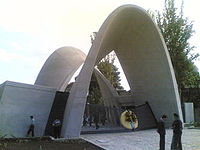

Tehran is the biggest and most important educational center of Iran. Today there are nearly 50 major colleges and universities total in Greater Tehran.
Since the establishment of Darolfonoon in the mid-19th century, Tehran has amassed a large number of institutions of higher education. Some of these institutions have played crucial roles in the unfolding of Iranian political events. Samuel M. Jordan, whom Jordan Avenue in Tehran is named after, was also one of the founding pioneers of the American College of Tehran. Among major educational institutions located in Tehran, Sharif University of Technology, is the most prestigious technological university of Iran and University of Tehran is the largest and oldest state university in Iran and one of the oldest in Central Asia and Middle East.
Amirkabir University of Technology (Tehran Polytechnic), K.N.Toosi University of Technology, Iran University of Science and Technology, Shahid Beheshti University (Melli University), Iran University of Medical Sciences, Shahed University and Tarbiat Modarres University are other highly ranked universities of Iran located in Tehran.
Tehran is also home to Iran's largest military academy, and several religious schools and seminaries.
-
 Dar ul-Funun, Iran's first Modern institute of higher education, founded in 1851
Dar ul-Funun, Iran's first Modern institute of higher education, founded in 1851
-
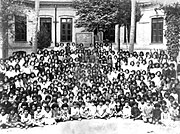 Tarbiyat School in 1911
Tarbiyat School in 1911
-
American College of Tehran
-
 College of Engineering
College of Engineering
-
Sharif University
Sport
See also: Sport in IranTehran was the first city in the Middle East to host the Asian Games. The 7th Asian Summer Games in 1974, was held with the participation of 2,363 athletes and officials from 25 countries.


Tehran is also the site of Iran's national football stadium on Azadi Sport Complex with 100,000 seating capacity. Azadi Football Stadium is biggest stadium in Iran and Middle East and one of the biggest in the World. Many of the top matches of Iran's Premier League are held here. In 2005, FIFA ordered Iran to limit spectators allowed into Azadi stadium because of a fatal crush and inadequate safety procedures. Other stadiums in Tehran are Shahid Dastgerdi Stadium, Takhti Stadium, and Shahid Shirudi Stadium, among others.
The ski resort of Dizin is situated to the north of Tehran in the Alborz Mountains. Tochal Ski Resort is the world's fifth highest ski resort, at over 3,730 metres (12,240 ft) at its highest 7th station. The resort was completed in 1976 shortly before the overthrowing of the Shah.
Here, one must first ride the eight kilometre (five mile) long gondola lift which covers a huge vertical and is probably the longest line in the world. The 7th station has three slopes. The resort's longest slope is the south side U shaped slope which goes from the 7th station to 5th station. The other two slopes are located on the north side of the 7th station. Here, there are two parallel chair ski lifts that go up to 3,900 metres (12,795 ft) near Tochal's peak (at 4,000 m/13,125 ft), rising higher than the gondola 7th station. This altitude is higher than any of the European resorts.
From the Tochal peak, one has a spectacular view of the Alborz range, including the 5,671 metre (18,606 ft) high Mount Damavand, a dormant volcano.
At the bottom of the lifts in a valley behind the Tochal peak is Tochal Hotel, located at 3,500 metres (11,483 ft) altitude. From there a T lift takes skiers up the 3,800 metres (12,500 ft) of Shahneshin peak, where the third slope of Tochal is.
Tochal 7th station has skiing eight months of the year. But there are also some glaciers and year-round snow fields near Tehran where skiing began in 1938, thanks to the efforts of two German railway engineers. Today, 12 ski resorts operate in Iran, but the most famous are Tochal, Dizin, and Shemshak, all within one to three hours of Tehran.
Football
In Football (soccer), Tehran is the host to four major football clubs in Iran's Premier Football League, namely:
| Club | Sport | Founded | League | Head Coach |
|---|---|---|---|---|
| Esteghlal F.C. | Football (soccer) | 1945 | Iran Pro League (IPL) | Parviz Mazloumi |
| Persepolis F.C. | Football (soccer) | 1963 | Iran Pro League (IPL) | Ali Daei |
| Steel Azin F.C. | Football (soccer) | 2007 | Iran Pro League (IPL) | Mohammad Khakpour |
| Naft Tehran F.C. | Football (soccer) | 1950 | Iran Pro League (IPL) | Hossein Faraki |
-
Inside of Azadi Stadium
-
Outside of Azadi Stadium
-
 International Snowboard championship in Tochal Ski Resort, Tochal
International Snowboard championship in Tochal Ski Resort, Tochal
- File:Dizin05.jpg
-
Azadi Indoor Stadium
Architecture and landmarks
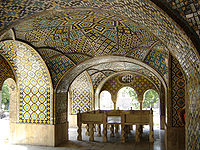
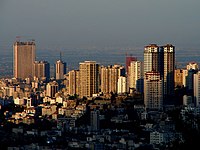
- See also Architecture of Tehran
Tehran is a relatively old city; as such, it has an architectural tradition unique to itself. Archaeological investigations and excavations in Tehran demonstrate that this area was home to civilizations as far back as 6,000 years BC. Tehran served only as a village to a relatively small population for most of its history, but began to take a more considerable role in Iran after it was made the capital in the late 18th century. Despite the occurrence of earthquakes during the Qajar period and before, some buildings still remain from Tehran's era of antiquity. Today Tehran is Iran's primate city, and has the most modernized infastructure in the country; however, the gentrification of old neighborhoods and the demolition of buildings of cultural significance has caused concerns.
The Azadi Tower has been the longstanding symbol of Tehran. It was constructured to commemorate the 2,500th anniversary of the Persian empire, and was originally named "Shahyad Tower"; after the Iranian revolution, its name changed to "Azadi Tower," meaning "Freedom Tower." The recently constructed Milad Tower may eventually replace the Azadi Tower as Tehran's new symbol. The Milad complex contains the world's fourth tallest tower, several restaurants, a five star hotel, a convention center, a world trade center, and an IT park. Traditionally a low-rise city due to seismic activity in the region, modern high rise developments in Tehran have been undertaken in order to service its growing population. There have been no major quakes in Tehran since 1830.
The tallest residential building in Iran is a 54-story building located North of Youssef Abad district, the Tehran International Tower. It is architecturally designed similar to Mandalay Bay Resort and Casino on the Las Vegas Strip in the Paradise community of Clark County, Nevada, United States. Appealing to the principle of vertical rather than horizontal expansion of the city, the Tehran International Tower is bound to the North by Youssef Abad, to the South By Hakim Highway, to the East by Kordesstan Highway and to the West by Sheikh Bahai Highway, all of which facilitate access to various parts of the city. Tehran has a beautiful skyline with many midrise buildings and towers.
- Tehran International Tower, A.S.P complex Tehran International Tower, A.S.P complex
-
 Skyline of Elahiyeh & Fereshteh
Skyline of Elahiyeh & Fereshteh
- Skyline of Tehran Skyline of Tehran
-
 Azadi Tower (Freedom tower)
Azadi Tower (Freedom tower)
- Keshavarzi Building which houses Iran's Ministry of Agriculture Keshavarzi Building which houses Iran's Ministry of Agriculture
- Goldis Tower Goldis Tower
- A view of Shahrak-e Gharb from south A view of Shahrak-e Gharb from south
-
 A view of Northern Tehran
A view of Northern Tehran
-
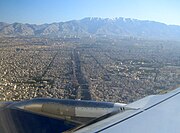 General view of Southern Tehran
General view of Southern Tehran
Tourism and attractions
See also: Tourism in Iran
Tehran, as Iran's showcase and capital city, has a wealth of cultural attractions. The Peacock Throne of the Persian Kings (Shahs) can be found in Tehran's Golestan Palace. Some of the well-known museums are National Museum of Iran, Sa'dabad Palaces Complex, Glassware and Ceramics Museum of Iran, The Carpet Museum of Iran, Tehran's Underglass painting Museum, Niavaran Palace Complex, and Safir Office Machines Museum. The Tehran Museum of Contemporary Art features the works of great artists such as Van Gogh, Pablo Picasso and Andy Warhol. The collection of these paintings was selected by the former Empress Farah Diba.
Tehran is also home to the Iranian Imperial Crown Jewels, also called the Imperial Crown Jewels of Persia, it is claimed to be the largest, most dazzling and valuable jewel collection in the world. The collection comprises a set of crowns and thrones, some 30 tiaras, numerous aigrettes, jewel-studded swords and shields, a vast amount of precious loose gems, including the largest collections of emeralds, rubies and diamonds in the world. It also includes other items collected by the Shahs of Iran during the 2,500 year existence of the Iranian Kingdom. The Imperial Crown Jewels are still on display in the Iranian Central Bank in Tehran.
Tehran International Book Fair (TIBF) Is known to the International Publishing World as the most important publishing event in Asia and the Middle East.
Recreation
The most popular social activity, especially among the younger generation is cinema. Most cinema theatres are located downtown. The Azadi Cinema was inaugurated in 2008. It is the largest cinema theatre in Tehran with ten salons. The Iram Zoo and Iram City Game are also popular meeting points, especially for families with children. A new larger zoo is planned for 2010.
Artists often mingle at the House Of Artists. Theatre Shahr was opened in 1962. It is the largest theatre in Tehran and the Middle East. Tehran TV 1, Tehran Cinema TV, Omid TV and Tehran Show TV are among the most popular TV stations in Tehran. Tehran TV2, Tehran TV3 and Tehran Sport are planned to be launched in 2010.
The following table shows some places for outdoors activities in Tehran:
| Tochal Ski resort | Darband hiking trail | Chitgar Park | Niavaran Park | Sa'ei Park | Daneshju Park | Goft-o-gū Park |
| Mellat Park | Laleh Park | Jamshidieh Park | Shatranj Park | Darabad hiking trail | Darakeh hiking trail | Jahan-e Kudak Park |
| Azadi sports complex | Enghelab Sports Complex and Golf course | Latyan Lake | Lavizan Forest Park | Vardavard Forest Park | Khajeer National Park | Kavir National Park |
| Tar Lake | Amir Kabir Lake | Lar Protected Natural Habitat | Varjeen Protected Natural Habitat | Pardisan | Tangeh Savashi | Farahzad |
- Statue of Abu Rayhan Biruni in Laleh Park Statue of Abu Rayhan Biruni in Laleh Park
-
 Azadi Cinema
Azadi Cinema
-
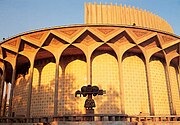 City Theatre
City Theatre
-
 Museum of Contemporary arts
Museum of Contemporary arts
Religious Centers
See also: List of Religious Centers in TehranThere are many religious centers scattered around in the city from old to newly built centers. There are mosques, churches, and synagogues where followers of these religions can practice their faith.
The Friday prayer in Tehran is usually hosted by University of Tehran which is led by a Friday prayer leader and on special occasions by the Supreme Leader of Iran. Hundreds of thousands of people participate in the prayers, during which the city of Tehran comes to a standstill.
Sister cities
| Country | City | |
|---|---|---|
| United States | Los Angeles | |
| Russia | Moscow | |
| South Korea | Seoul | |
| Philippines | Manila | |
| Belarus | Minsk | |
| Cuba | Havana |
Events
- 1974 Asian Games: The 7th Asian Games were held from September 1, 1974 to September 16, 1974 in Tehran, Iran. The Azadi sports complex was made for the Games. The Asian Games were hosted in the Middle East for the first time. Tehran, the capital of Iran, played host to 3,010 athletes coming from 25 countries/NOCs, the highest number of participants since the inception of the Games.
- 1976 AFC Asian Cup: The 1976 AFC Asian Cup was the sixth edition of the Asian Nations Cup, the football (soccer) championship of Asia (AFC). It was hosted by Iran. The field of six teams was split into two groups of three. Iran won their third title in a row, beating Kuwait in the final 1-0.
- 1997 West Asian Games: The 1st West Asian Games was first organized in Tehran from 19 to 28 November 1997. It was considered the first of their kind. The success of the games led to the creation of the West Asian Games Federation (WAGF) and the intention of hosting the games every two year.
- 2010 West Asian Games: Tehran will be the host city for the 4th West Asian Games that will be held in a few months.
Pictures
Panoramic view
 Panoramic view from Tehran
Panoramic view from Tehran
 Panoramic view from Tehran at night
Panoramic view from Tehran at night
See also
- Architecture of Tehran
- City Council of Tehran
- Tehran International Fairgrounds
- Tehran Stock Exchange
- International rankings of Iran
- Template:Wikitravel
References
- Statistical Center of Iran - 2006 Census
- "Microsoft PowerPoint - Day1_2_Network, Transit & Travel Demand Modelling in Iran Using EMME2" (PDF). Retrieved 2010-11-12.
- "World: largest cities and towns and statistics of their population". Retrieved 5 August 2010.
- Tehran Oil Refining Company Official Website. Tehran Oil Refining Company Official Website
- By Les Christie, CNNMoney.com staff writer (2007-03-06). "World's most expensive cities - Mar. 5, 2007". Money.cnn.com. Retrieved 2010-09-25.
{{cite web}}:|author=has generic name (help) - "Survey: Eight of ten most expensive cities are in Europe". World Economies. 2007-03-06. Retrieved 2010-09-25.
- "World's most expensive cities (EIU)". City Mayors. 2008-06-17. Retrieved 2010-09-25.
- "Tehran remains least expensive city in the world among 124 surveyed cities". Payvand.com. Retrieved 2010-09-25.
- "Top 10 Cheapest Cities In The World". Housingnepal.com. 2009-02-28. Retrieved 2010-09-25.
- "World Urbanization Prospects: The 2009 Revision Population Database". Esa.un.org. Retrieved 2010-09-25.
- "World's largest urban areas in 2006 (1)". City Mayors. Retrieved 2010-09-25.
- Behrooz, Samira; Karampour, Katayoun. A Research on Adaptation of Historic Urban Landscapes ; The Case of The Historical City of Tehran. Tehran Historical City Office.
- "Climate of Tehran". Irantour.org. Retrieved 2010-11-12.
- Heavy Snowfall in Tehran (in Persian)
- http://www.irimo.ir/farsi/drought/synopH/Tehranmehrabad.txt
- "Chand Darsad Tehranihaa dar Tehran Bedonyaa Amadand"(How many percent of Tehranis were born in Tehran), accessed December, 2010
- ^ "For Security and Admnistrative Reasons: Plan to Move Capital From Tehran Finalized". Payvand.com. Retrieved 2010-09-25.
- "Iran Moots Shifting Capital from Tehran". Payvand.com. 2006-11-22. Retrieved 2010-09-25.
- "No Operation". Presstv.com. Retrieved 2010-09-25.
- britannica.com, accessed: June 2009.
- "Slide 1" (PDF). Retrieved 2010-09-25.
- BBC: http://news.bbc.co.uk/1/hi/business/3129995.stm
- "'Tehran's overpopulation will cause ecological ruin'". Payvand.com. 2006-11-22. Retrieved 2010-11-12.
- Tehran. An Educational Website about Tehran
- هر روز 27 تهرانی به دليل آلودگی هوا می ميرند. September 18, 2006
- Iran smog 'kills 3,600 in month'. BBC News Online. January 9, 2007
- "Car exhaust fumes blamed for over 80% of air pollution in Tehran". Payvand.com. 2006-11-22. Retrieved 2010-09-25.
- "Motorcycles Account for 30% of Air Pollution in Tehran". Payvand.com. 2006-11-22. Retrieved 2010-11-12.
- The Economist, "The smoggiest of all capitals", 1 January 2011, p. 40.
- http://www.tochal.org/en/telecabin_introduction.asp
- Esteghlal F.C. Official Website. Esteghlal F.C.
- Persepolis F.C. Official Website. Persepolis F.C.
- Tehran Capital City of Iran. Tehran
- The Style of Tehran. Library of Congress. Retrieved 04-13-2008.
- Milad Tower Official Website. Milad Tower
- "Women to blame for earthquakes, says Iran cleric". The Guardian. 2010-04-19.
- ^ Tehran International Tower Website. Tehran International Tower Website
- tibf. Retrieved June 2009.
- http://www.lacity.org/SisterCities/html/11.htm
- http://el.mos.ru/cgi-bin/pbl_web?vid=2&osn_id=0&id_rub=2368&news_unom=35877
- "Sister Cities of Manila". © 2008-2009 City Government of Manila. Retrieved 2009-09-02.
{{cite web}}: External link in|publisher= - "Каталог организаций — Минский городской исполнительный комитет". Minsk.gov.by. Retrieved 2010-09-25.
- 7th Asian Games. Asian Games
- West Asian Games. West Asian Games
External links
- Google Map: Tehran
- Tehran Municipality website
- Tehran Geographic Information Center
- Tehran Traffic Control Center
- Official Tehran Yellow pages (Ketabe Avval)
- Tehran things to do Questions & Answers about Tehran.
- Videos
- Tehran today - Part I Part II Part III (PressTV documentary)
- Modernized Iranian architecture in Tehran (Video, 6 min 48 sec), Press TV, 26 September 2010.
- Tehran's hazardous air quality - PressTV documentary (2010)
Template:Link FA Template:Link FA Template:Link FA
Categories:





